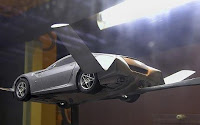 I remember reading the news with mixed feelings. Instinctively, the study confirmed what I've always sort of known, that traffic in this city is indeed ridiculous. On the other hand, having been to L.A. and NYC several times, I had trouble believing we were worse off than the denizens of those particular cities. Driving in Toronto is bad, but driving in L.A. and New York is a nightmare. Regardless, the study certainly confirmed that getting around Toronto sucks big time.
I remember reading the news with mixed feelings. Instinctively, the study confirmed what I've always sort of known, that traffic in this city is indeed ridiculous. On the other hand, having been to L.A. and NYC several times, I had trouble believing we were worse off than the denizens of those particular cities. Driving in Toronto is bad, but driving in L.A. and New York is a nightmare. Regardless, the study certainly confirmed that getting around Toronto sucks big time.Luckily, the wonderful wizards at DARPA (the U.S. military's mad-science lab) are coming to the rescue - hopefully. Defense Technology International had a recent article (clicking on that will bring up a PDF) about the Defense Advanced Research Projects Agency's new program for developing a flying car.
As the article states, flying cars have been inventors' pipe dreams for decades. DARPA, however, is looking to dust the idea off from nutcase obscurity in an effort to create vehicles that can avoid the threat of Improvised Explosive Devices, a major threat to soldiers and civilians alike in Iraq and Afghanistan.
Similar to its Grand Challenge races, where teams built robot cars that drove themselves, DARPA is now challenging all comers to put together a flying car. The conditions: the car must drive like a Humvee on the ground, rapidly reconfigure for flight and change back for ground operations. Not surprisingly, the project is being called "Transformer," or TX. The vehicle must also be able to fly at a speed of at least 120 miles per hour, or the speed of a light aircraft. "If you’re slower than that, it might be better to drive," said a DARPA official.
The agency wants a prototype within four years and, so far, the Marines have shown an interest in buying such a car. They believe it could be useful for medical evacuation or supply drops. The other military branches, including Army, Air Force and Navy, however, are skeptical.
By-products of the Grand Challenge, such as laser radar and lane detectors, are already working their way into commercial vehicles. If DARPA's flying-car project is even semi-successful, you can be sure there will be similar consumer spinoffs. On behalf of those of us living in Toronto, L.A., New York and other gridlocked cities, I'd just like to say that I hope DARPA's project succeeds with - if you'll pardon the pun - flying colours.
0 comments:
Post a Comment